Self-employment and small business are two sides of a single economic coin: financial independence. The
Bureau of Labor Statistics (BLS) counts two types of self-employed, the
unincorporated and the incorporated. The unincorporated may have
employees, but typically do not, i.e. they are sole proprietors. The
incorporated have employees, starting with the owner, as the BLS counts
the incorporated self-employed as employees of their own corporation.
I know that’s confusing, but it’s important to separate the sole
proprietors from those “self-employed” incorporated businesses that have
employees: law firms, doctors’ offices, accountants, etc.
When we speak of “small business,” we’re referring in large part to
the incorporated self-employed: people who establish corporations as
the legal structure for their enterprise.
Nothing is simple when it comes to parsing all the data, of course, but the BLS has a paper that explains the basic categories: Self-employment in the United States (Bureau of Labor Statistics).
The BLS attributes the decline in unincorporated self-employment
from 1950 to 1970 to the consolidation of agriculture. As agriculture
became more mechanized, small farms were no longer viable and farming
required less labor. As a result, many self-employed farmers and
laborers became employees or moved to other sectors.
The trajectory of self-employment from 1970 to the mid-2000s
tracked general economic growth, which was weak in the 1970s but began a
30-year boom in the early 1980s.Things changed in the recession, as the self-employed ranks have lost 1.6 million from the peak in 2007. The number of self-employed has fallen to early 1980s levels: (All FRED charts courtesy of frequent contributor B.C.)
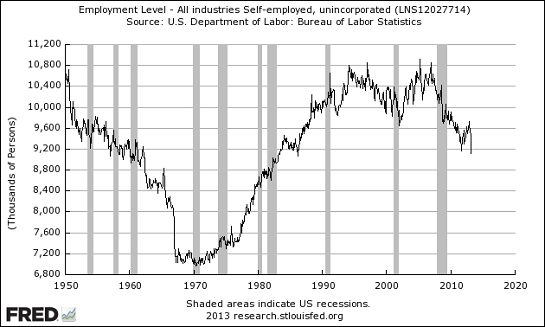
This chart displays the self-employed as a share of total non-farm employment.The
first chart showed a strong rise in self-employment from 1970, but this
chart shows that employment rose even faster: the self-employed share
of all those employed has been declining for 30 years:
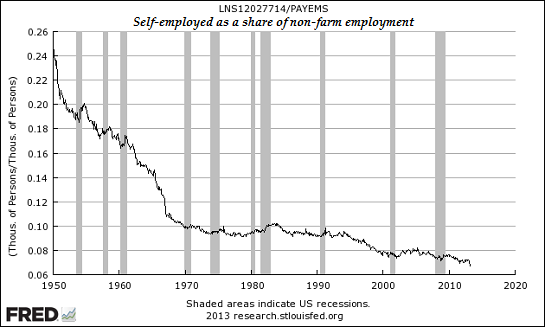
We can attribute this trend to the rise of global Corporate America and government employment. The
workforce expanded, and relatively more people became employees of
corporations or the government than became self-employed.
It’s important to note here that the BLS does not break down the income of unincorporated self-employed: if
millions of self-employed saw their net incomes slashed in the
recession, the BLS still counts them as self-employed. So a consultant
who earned $100,000 prior to the recession and now scrambles to net
$10,000 is still self-employed.
This is the statistical equivalent of 6 million people losing
full-time jobs and then 4 million of those people getting part-time
jobs. Did employment truly recover most of the losses?
This chart displays total non-farm employment (blue) and the incorporated self-employed. Unsurprisingly, the rise and decline of the incorporated self-employed tracks the general economy and total employment.
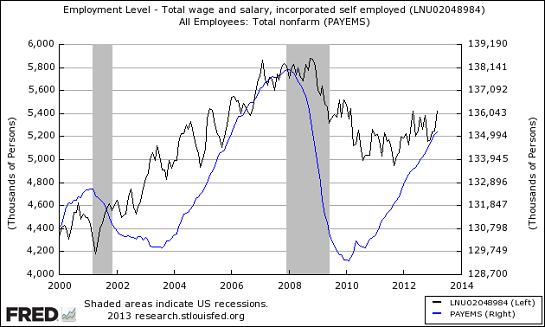
But once again we have to note the limitations of the data. As
B.C. observed, some of the recent rise in incorporated self-employed is
the result of tax policies favoring corporations; the newly
incorporated may well not have any employees, i.e. they are simply sole
proprietors who incorporated for the tax benefits:
Historically, in order for incorporated self-employment to grow, it requires an increasing share of the population that is inclined to, or capable of, first becoming unincorporated self-employed. A growing share of the incorporated self-employed since the ’00s are one-person S corporations (to take advantage of favorable tax treatment) or limited partnerships (LPs) and limited liability corporations (LLCs) in real estate for pass-through purposes that hire few, if any, employees.Consider that the US employment base is disproportionately dependent upon the viability of as few as 4% of the labor force and fewer than 2% of the population as the primary “job creators”, i.e., incorporated self-employed.
After a brief increase in 2012, the self-employed as a share of total employment is falling off a cliff:
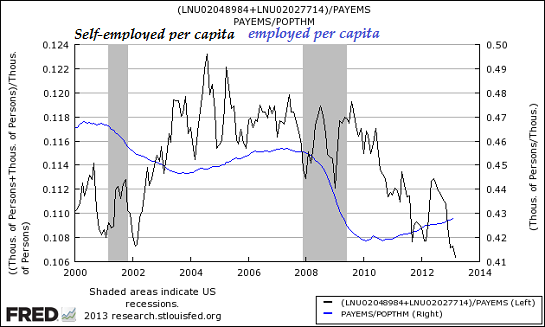
Spend some time walking through Silicon Valley or New York City, and you’ll likely leave under the impression that entrepreneurship is alive and well in the United States. But spend some time wading through some of the latest census data, and you may come away with a very different impression.
This trend is reflected in the decline of small business in general:
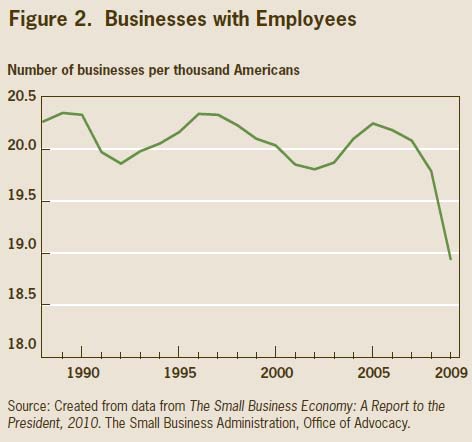
Although many analysts claim most employment growth now comes from
corporations, once again we have to look beneath the surface and ask
what kind of jobs are corporations creating? More part-time fast-food
positions?
Small business plays two critically important and often unrecognized roles. One,
it tends to give new workers their first employment experience. The
corporate human resources departments are not so forgiving–have you had
your third interview yet? Only two more to go….
Two, small business tends to train workers who are then able to
move up the job ladder to better paying corporate jobs, having learned
the ropes at a small business. If you talk to corporate insiders, they
will admit (in private) that their own job training efforts are limited:
it’s faster and more productive to poach your new hires from a
competitor than invest years bringing up new talent.
Corporations may point to their intern program as “job training,”
but this is all too often a PR facade for unpaid slave labor. How many
interns learned anything remotely useful? How many end up with full-time
jobs at the company? The typical answer is: very few.
Small business is the incubator of employment. As it declines, so
too do opportunities for first jobs, second chances and economic
independence.

A few decades ago, large supermarket chains began to open in Australia.
ReplyDeleteSmaller & family owned & run supermarkets, grocery stores, butcher shops, delicatessens, fruit shops, milk bars/the corner store, were driven out/closed down.
Many people went broke & many jobs were permanently destroyed .
Today at my local shopping center we have 2 Coles supermarkets & 1 Woolworths supermarket, a small market & an assortment of smaller traders.
It is very expensive to run a large supermarket.
It is very expensive to run a chain of large supermarkets.
It is so expensive that you cannot make profit no matter what.
This is the absolute truth.
Eventually you realize this fact & know that you must close.
The ACE UP YOUR SLEEVE is that you have eliminated most of the competition.
Who will feed the people ?
You are now vital & intricate to the community.
What to do /?
The government is in deep trouble for allowing this scenario to come about in the first place.
You see, at the first, the people were against the large supermarket chains taking over & foretold that it would become a disaster.
Ever so QUIETLY the Federal & State Governments collude & decide that the only solution is to SUBSIDIZE the supermarket chains ....
WITH
WAIT FOR IT
TAX PAYERS DOLLARS
So today in Australia we have Tax Payer Funded supermarkets / shhhh ! the people don't know.
We pay to keep the supermarkets open & we pay top dollar for the food that we purchase from the very same supermarkets that we subsidize.
In the mean time the Health Care budget is being slashed.
In the same mean time the Education Budget is being slashed.
Let me tell you the OLIVE OIL STORY :-
ReplyDeleteOlive Oils in Australia, sold for $48.00 per 4 liter can, about $12 per liter - DOUBLE THE PRICE OF CANOLA OIL.
It was realized that, from clearing the land to the bottling of the oil, it is so much cheaper to produce Olive Oil than it is to produce Canola Oil.
And yet we were paying double for the Olive oil ... this was very strange to say the least /?
Questions were asked, pressure was brought to bear;
From EXTERNAL forces & not the government regulators or any price watch dogs; & the price of Olive Oil fell by 1/2. It fell to & is still today, 2 years later, $23.00 per 4 liter can.
The other thing is this :-
Cheaper imports of Olive Oils, which should have been then, & should today be cheaper were & still are selling for the same price as the expensive Australian Olive Oil.
Also :-
Because the price of Olive Oil was so high it was not selling, which meant that the Australian Olive Growing Industry was not viable & was about go under.
Yes ! they were about to pull up all the trees.
Fortunately the price going down caused sales of Olive Oil to go up dramatically & there by saved the Australian Olive Growing Industry.
Whats more, Spain is currently suffering shortages in their Olive Oil Production so Australia is now exporting Olive Oil to Spain.
Left to the greedy look what would have happened...
These people do not know what they are doing .
The owners of these large stores are not business people, but vandals & looter.